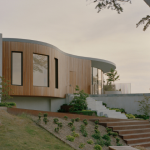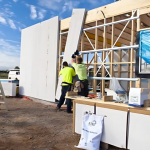Remote cabin in the woods is a quarantine dream
We’ve all heard the stories of the nightmares of quarantine; trapped in a windowless rooms lacking in fresh air (and nothing close to palatable food).
Now what if I told you, you could quarantine in a self-contained cabin in the woods with no one around for miles? Sounds like something people would volunteer for happily (and do, judging by the new influx of cabin searches on Airbnb).

GALLERY
The Collserola natural park, in the surroundings of Barcelona, is the setting for The Voxel project, produced by a team made up of students, professionals, and experts from the Master in Advanced Ecological Buildings and Biocities (MAEBB) of the Institute of Advanced Architecture of Catalonia (IAAC) Valldaura Labs. It is a quarantine cabin designed for the self-confinement of one occupant. The project was designed entirely under quarantine conditions and is an architectural response to the current crisis.
The cabin is very near to the headquarters of Valldaura Labs, the campus created by the Institute of Advanced Architecture of Catalonia (IAAC), focused on research and education on self-sufficient habitat.
The Voxel was designed and built during the MAEBB 2019-2020 master’s degree, with the consultancy of a group of experts formed by the directors of the master’s degree Daniel Ibáñez and Vicente Guallart, the energy expert Oscar Aceves, the water expert Jochen Scheerer, and the architects Elena Orte and Guillermo Sevillano, among others. It was built in just 5 months, turning the dense forest of Collserola, Barcelona, into the home of a truly ambitious project in the area of ecological architecture.
Designed as a quarantine cabin, the house can accommodate one occupant for 14 days, providing all material needs during self-confinement. The Voxel, or volumetric pixel, is a 12 square meter cross-laminated timber (CLT) structure made of Aleppo Pine (Pinus halepensis) that was milled, dried, processed, and pressed on-site at Valldaura. Using ‘zero kilometre’ materials – all timber used in the project was harvested within a radius of less than 1 kilometer from the construction site.
Based on a sustainable forest management plan approved in Collserola, a certain forest volume can be obtained each year to encourage the growth of smaller trees and biodiversity, because forest biomass grows by 3% each year and growing trees absorb more CO2.
The project responds to the interest in promoting a new generation of green buildings using structural cross-laminated timber (CLT), which is suitable to become a key material for constructing buildings that combat climate change.
To supply the raw materials of the project, 40 pine trees were harvested and cut into 3cm boards and stacked to dry for three months. After they reached the proper humidity level, each board was taken into the Valldaura Labs carpentry to be processed into hundreds of pine lamellas. Each lamella was then encoded into a specific sequence, tagged, and pressed into more than 30 structural CLT panels which were assembled into a 3.6×3.6m cube.
The panels were held together metal-free with lap joints and wooden dowels, inspired by a commitment to use less carbon-intensive materials. The structure was then wrapped in a layer of cork insulation and mounted with an innovative series of rain-screen panels made from waste material created during the CLT production process.
By advancing the design a step further, each off-cut was parametrically organized into a gradient that corresponds to functions within the cabin. Certain sections of the skin also extrude away from the cabin corresponding to metabolic components like water tanks and an outdoor shower. The roof of the cabin features a series of garden boxes with elaborate joints milled with computer-numerical-control (CNC) machinery (no screws, no glue), which holds a variety of local plants and funnel rainwater into a collection tank below.
Cork insulation was placed over the wooden panels, and a burnt wooden skin was placed over it, using the Japanese Shou Sugi Ban technique, which protects the building from the rain.
The cabin is equipped with three solar panels and independent battery storage, specifically designed to power the lighting and devices for a single resident. The water system incorporates both rainwater collection and grey-water recycling, as well as black-water treatment within a self-contained biogas system that generates usable cooking or heating fuel and sanitary fertilizer as by-products.
Now that the construction is complete, The Voxel stands as visceral proof of a forthcoming advanced and ecological architectural paradigm that uses hyper-local materials and industrialized techniques.
Images by Cortesía de Valldaura Labs via ArchDaily
Located on the shores of a man-made lake in Sorrento, Victoria, this ambitious build reflects the its natural ...
Big River Group has released MaxiWall, an autoclaved aerated concrete (AAC) solution that aims to be a sustainable, ...
Small and medium enterprises (SMEs) across Australia are facing growing challenges as payment delays continue to rise, putting ...
Perched atop one of Adelaide’s busiest CBD streets, SORA Rooftop & Bar is a venue defined by movement—both ...












